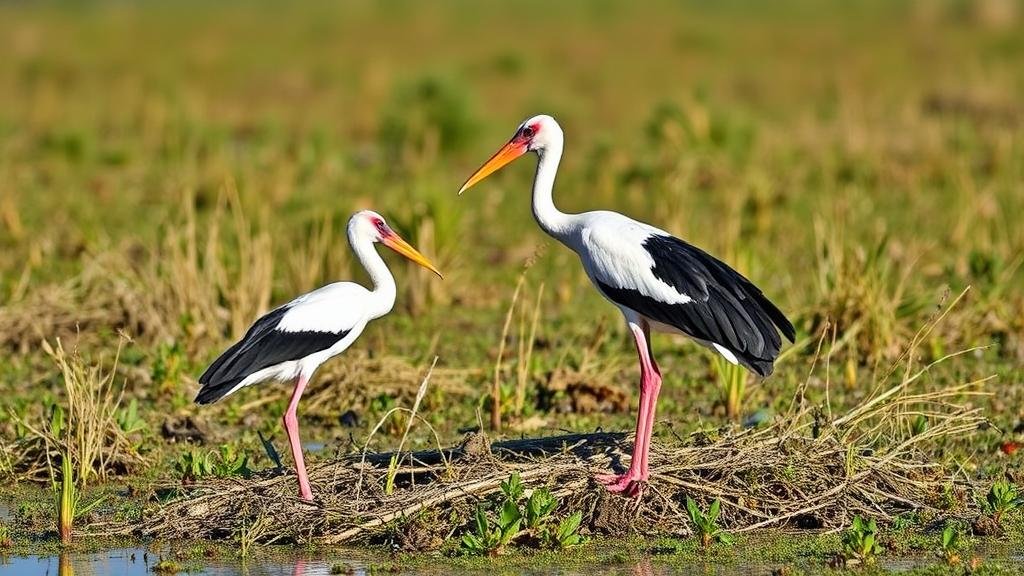Searching for shoebill stork nesting grounds in the wetlands of Africa.
Searching for Shoebill Stork Nesting Grounds in the Wetlands of Africa
The shoebill stork, known for its distinctive, large bill reminiscent of a shoe, is one of the most intriguing avian species found in Africa. This magnificent bird, scientifically classified as Balaeniceps rex, primarily thrives in the vast wetlands of East Africa, including regions such as Uganda, Zambia, and South Sudan. Their nesting grounds are vital for their breeding success and play a crucial role in the biodiversity of these ecosystems.
Characteristics of the Shoebill Stork
Shoebill storks are characterized by their large, long-legged stature, standing approximately 4 feet tall, with a wingspan that can reach nearly 8 feet. r striking appearance is complemented by their unique hunting style; they are known to patiently stalk fish, amphibians, and small reptiles in their wetland habitats. Their diet mainly consists of lungfish, which are abundant in these swampy areas.
Preferred Habitat and Nesting Grounds
The shoebill stork is predominantly found in freshwater swamps and marshes, where tall, densely packed vegetation provides the cover they need for nesting. A perfect nesting site consists of tall papyrus or bulrush, which not only offers protection from predators but also serves as a platform for building their nests.
Historically, shoebills have been reported in several key locations, which remain critical for their population sustainability. Some renowned areas include:
- Lake Albert: Located in Uganda, this area features extensive wetlands that provide ideal nesting opportunities for shoebills, especially in the northern sections.
- Bangweulu Swamps: In Zambia, these swamps are essential for shoebill stork breeding, where they nest in the densely vegetated areas.
- Sudd Wetlands: A large swamp in South Sudan, the Sudd is one of the world’s largest freshwater wetlands and hosts multiple shoebill pairs.
Nesting Behavior and Reproduction
The nesting season for shoebill storks typically occurs during the wet months, from March to September. Unlike many bird species, shoebills are somewhat solitary when it comes to nesting. They usually lay two eggs, and both parents participate in incubating the eggs over a period of about 30 days. After hatching, the chicks remain in the nest for approximately three months, during which the parents feed them regurgitated food.
Conservation Efforts
Due to habitat loss and hunting, the shoebill stork is classified as Vulnerable by the International Union for Conservation of Nature (IUCN). Efforts to protect their nesting grounds have become essential. Organizations and governments have initiated programs focused on:
- Establishing protected areas around critical wetland habitats.
- Conducting field research to monitor stork populations and their breeding success.
- Educating local communities on the ecological importance of preserving shoebill habitats.
Real-World Applications of Nesting Ground Research
Research into shoebill stork nesting grounds has valuable implications for broader biodiversity conservation efforts. Understanding their nesting behaviors enhances the preservation of wetland ecosystems that benefit various species. This research benefits not only the shoebills but the myriad of flora and fauna that share their habitat.
Conclusion and Actionable Takeaways
Searching for shoebill stork nesting grounds in Africa’s wetlands is not merely an avian observation; it represents a crucial aspect of conservation biology. Efforts to locate and protect these nests contribute to the broader mission of maintaining ecological health in wetlands, which are vital to numerous species and local communities.
To wrap up, by supporting conservation initiatives, raising awareness of the shoebills plight, and advocating for wetland ecosystem preservation, individuals can contribute to the survival of this remarkable bird. Whether through donations to environmental NGOs or engaging in volunteer opportunities, every action counts in ensuring that the shoebill stork continues to thrive in its natural habitat.



